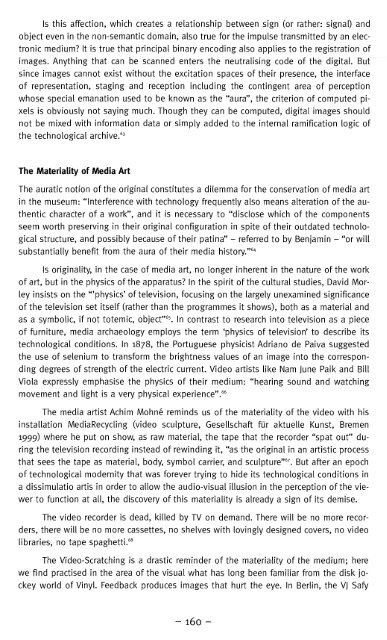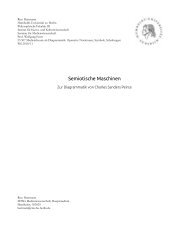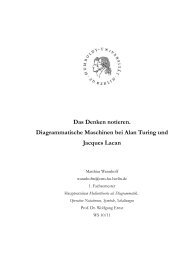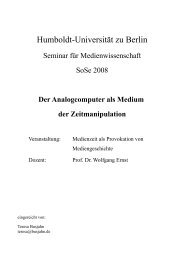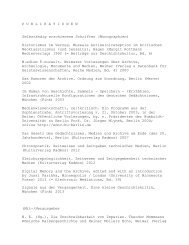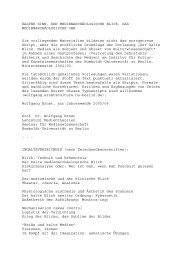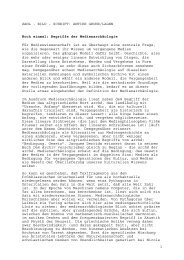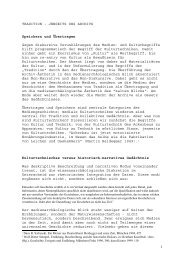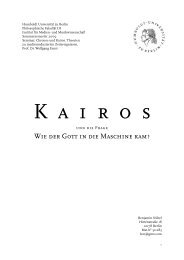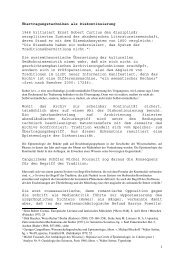Download - Medienwissenschaft
Download - Medienwissenschaft
Download - Medienwissenschaft
You also want an ePaper? Increase the reach of your titles
YUMPU automatically turns print PDFs into web optimized ePapers that Google loves.
Is this affection, which creates a relationship between sign (or rather: signal) and<br />
object even in the non-semantic domain, also true for the impulse transmitted by an electronic<br />
medium? It is true that principal binary encoding also applies to the registration of<br />
images. Anything that can be scanned enters the neutralising code of the digital. But<br />
since images cannot exist without the excitation spaces of their presence, the interface<br />
of representation, staging and reception including the contingent area of perception<br />
whose special emanation used to be known as the "aura", the criterion of computed pixels<br />
is obviously not saying much. Though they can be computed, digital images should<br />
not be mixed with information data or simply added to the internal ramification logic of<br />
the technological archive. 63<br />
The Materiality of Media Art<br />
The auratic notion of the original constitutes a dilemma for the conservation of media art<br />
in the museum: "Interference with technology frequently also means alteration of the authentic<br />
character of a work", and it is necessary to "disclose which of the components<br />
seem worth preserving in their original configuration in spite of their outdated technological<br />
structure, and possibly because of their patina" - referred to by Benjamin - "or will<br />
substantially benefit from the aura of their media history." 64<br />
Is originality, in the case of media art, no longer inherent in the nature of the work<br />
of art, but in the physics of the apparatus? In the spirit of the cultural studies, David Morley<br />
insists on the "'physics' of television, focusing on the largely unexamined significance<br />
of the television set itself (rather than the programmes it shows), both as a material and<br />
as a symbolic, if not totemic, object" 65 . In contrast to research into television as a piece<br />
of furniture, media archaeology employs the term 'physics of television' to describe its<br />
technological conditions. In 1878, the Portuguese physicist Adriano de Paiva suggested<br />
the use of selenium to transform the brightness values of an image into the corresponding<br />
degrees of strength of the electric current. Video artists like Nam June Paik and Bill<br />
Viola expressly emphasise the physics of their medium: "hearing sound and watching<br />
movement and light is a very physical experience". 66<br />
The media artist Achim Mohne reminds us of the materiality of the video with his<br />
installation MediaRecyding (video sculpture, Gesellschaft für aktuelle Kunst, Bremen<br />
1999) where he put on show, as raw material, the tape that the recorder "spat out" during<br />
the television recording instead of rewinding it, "as the original in an artistic process<br />
that sees the tape as material, body, symbol carrier, and sculpture" 67 . But after an epoch<br />
of technological modernity that was forever trying to hide its technological conditions in<br />
a dissimulatio artis in order to allow the audio-visual illusion in the perception of the viewer<br />
to function at all, the discovery of this materiality is already a sign of its demise.<br />
The video recorder is dead, killed by TV on demand. There will be no more recorders,<br />
there will be no more cassettes, no shelves with lovingly designed covers, no video<br />
libraries, no tape spaghetti. 68<br />
The Video-Scratching is a drastic reminder of the materiality of the medium; here<br />
we find practised in the area of the visual what has long been familiar from the disk jockey<br />
world of Vinyl. Feedback produces images that hurt the eye. In Berlin, the VJ Safy<br />
- 160 -


